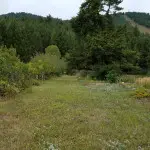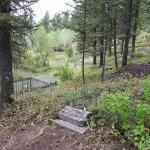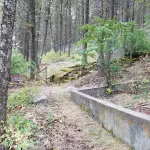Located in Jackson at the base of Snow King, between two ski trails, lies the Aspen Hill Cemetery. On July 8, 1920 Mayor Grace Miller and her all-female town council voted and signed the paperwork dedicating this site as an official cemetery. At this time, around 25 marked graves were already on the public land, but the town had yet to purchase it outright for cemetery use. Part of the agreement included the installment of an official road system, still in use today. The earliest graves here were something of a challenge for the early residents of Jackson. Not wanting to take up valuable homesteading land, they looked to the ledged hillside standing over the small town site. These early burials were haphazard, and few thought to properly survey the sites; there were no mortuary services in town yet. The deceased were often laid out on general store counters, and digging sometimes resulted in the disturbance of existing graves. The female town council were aware of these problems, and sought to bring them to an end, to honor the dead. Many of Jackson Hole’s most notable residents are buried here.
Charles Fox (1862-1936) Location: 10-1-8
Charlie Fox first came to Jackson in 1910. He was the first professional building contractor to move into the valley, and because of his skills, he is responsible for most of the construction projects. His most-known project is the Chapel of Transfiguration in Moose. Fox also built cabins at the Bar BC, JY and Flat Creek Ranches. Before Charlie arrived, many homesteaders had to figure out how to build their homes on their own. Many were already experienced craftsmen, but many were not. These earlier homes were often taken down and replaced when more experienced builders like Charlie Fox arrived, or they fell down.
Dr. Charles Huff (1888-1937) Location: 9-1-3
Dr. Huff arrived in the valley in 1913 and became the first doctor to stay there year-round and create a home. There had been a brief visit by a doctor in 1909, but he didn’t stay more than a few months. Dr. Huff was welcomed by the whole valley, and he often made trips from one end to the other on horseback without stopping. His wife Edna, was the valley’s first educated nurse. Many women throughout the valley were skilled midwives, but had not received formal training. Dr. Huff was instrumental in finding support and funding to construct the valley’s first hospital. One of the original buildings still stands at the St. John’s Episcopal Church on Glenwood Street. The hospital also contained the valley’s first elevator. Because it operated so slowly, the community started keeping track of the number of babies born in the elevator rather than in the upstairs operating room.
Margaret “Maggie” S Simpson (1846-1921) Location: 3-8-47
In 1894, John and Maggie Simpson were one of the first homesteaders within the town of Jackson boundaries. Their homestead on Cache Creek is today the largest open parcel of land in East Jackson, located off Rancher Street. Maggie Simpson is responsible for naming the town “Jackson.” The first post office in the valley was located at the Fred and Mary White ranch. Fred named the post office “Marysvale” after his wife. In 1894, Maggie Simpson became the new postmaster and decided that the town should have a more recognizable name, and picked Jackson after “Jackson’s Hole.” The Simpsons owned the land that would become the town square, and sold it to mayor Grace Miller with the intention of establishing a town center.
Stephen Nelson Leek (1858-1943) Location: 1-9-107
Stephen Leek initially visited the Jackson Hole valley as a fur trapper, and found his permanent home in South Park in 1887. His homestead is located in the field just south of Smith’s, just across from Leek’s Canyon. Stephen continued guiding hunters throughout the valley, establishing a camp at what is known today as Leek’s Marina. The old chimney just to the west of the parking lot is the only remaining piece of his lodge. One of Stephen’s favorite clients was George Eastman, owner of the Eastman-Kodak Company. George gave Stephen a camera, which Stephen put to use documenting the deteriorating health of the elk herds in the valley. Using his now-famous photos, Stephen convinced Congress to pass legislation creating the National Elk Refuge in 1912.
Today the cemetery holds over 600 marked burials and is notably unique in its geography. Located at the base of Snow King mountain, the cemetery is rugged, steep and wild, a character that reflects much of the valley’s history.
When visiting the cemetery, please be respectful of all posted signage and other visitors.
Learn more from the Town of Jackson here.




